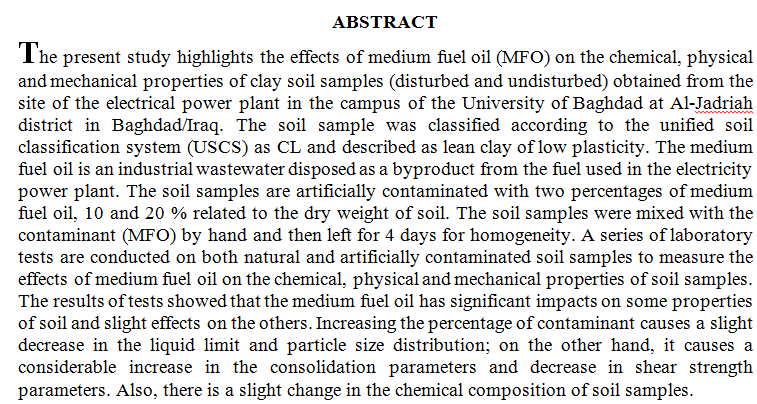
Gypseous soils represented one of the most complex salty soils that faced the geotechnical engineers. Structures that built on gypsum soil will undergo unexpected distortions that will eventually contribute to catastrophic failure. The purpose of this article is to understand the durability of gypsum soil against wetting drying cycles after improvement with polyurethane polymer especially investigate the effect of the wetting-drying cycle on collapsibility. The soil was brought from Sawa lake in AL-Muthanna Governorate in Iraq, with gypsum content 65.5%, A set of Odometer tests were performed to determine the collapsibility potential (CP) for treated and untreated gypsum soil. The result shows that adding a different per
... Show More (48)
(48)
This paper analyzes a piled-raft foundation on non-homogeneous soils with variable layer depth percentages. The present work aims to perform a three-dimensional finite element analysis of a piled-raft foundation subjected to vertical load using the PLAXIS 3D software. Parametric analysis was carried out to determine the effect of soil type and initial layer thickness. The parametric study showed that increasing the relative density from 30 % to 80 % of the upper sand layer and the thickness of the first layer has led to an increase in the ultimate load and a decrease in the settlement of piled raft foundations for the cases of sand over weak soil. In clay over weak soil, the ultimate load of the piled raft foundation w
... Show MoreThe aim of the research was to prepare Pilates exercises using the barrel ladder apparatus and to identify the effect of Pilates exercises on agility, coordination, and motor sequences of third-year female students in artistic gymnastics. The researcher adopted the experimental method to achieve the objectives of the study and to verify its hypotheses, as it is suitable for the nature and problem of the research. In selecting the research population, the researcher carefully chose the sample using a purposive method, clarifying its elements and constituent units. The research population consisted of third-year female students at the College of Physical Education and Sports Sciences for Women / University of Baghdad, with a total of 20 stud
... Show MoreThis research aims at studying each of the cold and hot thermal wavelengths affecting
Iraq for a minimum climatic course of 11 years beginning from 1992 till 2002. Three stations
were selected including the parts of Iraq surface: Mosul, Baghdad and Basrah.
The wave days were also connected with the related climatic elements represented by
the wind direction and speeds and the relative humidity. It was shown that Iraq is affected by
the rates of hot thermal wave lengths greatly compared to the rates of cold wavelengths. The
results suggested that the highest rate of hot and cold wavelengths recorded over Basra station
was (3.5) days for the cold and (5) days for the hot. While the lowest rates was at Mosul
station
Optical detector was manufactured Bashaddam thermal evaporation technique at room temperature under pressure rays studied characteristics of reactive Scout efficiency quantitative ratio of the signal and the ability equivalent to noise
 (22)
(22)
 (21)
(21)
Low grade crude palm oil (LGCPO) presents as an attractive option as feedstock for biodiesel production due to its low cost and non-competition with food resources. Typically, LGCPO contains high contents of free fatty acids (FFA), rendering it impossible in direct trans-esterification processes due to the saponification reaction. Esterification is the typical pre-treatment process to reduce the FFA content and to produce fatty acid methyl ester (FAME). The pre-treatment of LGCPO using two different acid catalysts, such as titanium oxysulphate sulphuric acid complex hydrate (TiOSH) and 5-sulfosalicylic acid dihydrate (5-SOCAH) was investigated for the first time in this study. The optimum conditions for the homogenous catalyst (5-SOCAH) wer
... Show More (14)
(14)
 (13)
(13)
The evaluation of subsurface formations as applied to oil well drilling started around 50 years ago. Generally, the curent review articule includes all methods for coring, logging, testing, and sampling. Also the methods for deciphering logs and laboratory tests that are relevant to assessing formations beneath the surface, including a look at the fluids they contain are discussed. Casing is occasionally set in order to more precisely evaluate the formations; as a result, this procedure is also taken into account while evaluating the formations. The petrophysics of reservoir rocks is the branch of science interested in studying chemical and physical properties of permeable media and the components of reservoir rocks which are associated
... Show More (6)
(6)
In this work, the effects of size, and temperature on the linear and nonlinear optical properties in InGaN/GaN inverse parabolic and triangular quantum wells (IPQW and ITQW) for different concentrations at the well center were theoretically investigated. The indium concentrations at the barriers were fixed to be always xmax = 0.2. The energy levels and their associated wave functions are computed within the effective mass approximation. The expressions of optical properties are obtained analytically by using the compact density-matrix approach. The linear, nonlinear, and total absorption coefficients depending on the In concentrations at the well center are investigated as a function of the incident photon energy for different
... Show More (6)
(6)
